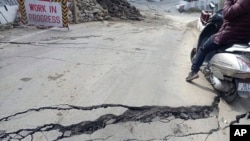Hundreds of people have been evacuated from their homes in a Himalayan town in North India where the land is slowly sinking.
In Joshimath, panicked residents began moving their belongings out of their homes earlier this month after cracks developed in about 700 of the roughly 4,500 buildings in the town, raising safety concerns.
Scores of families have been shifted to relief camps set up in local hotels and schools in recent days and disaster response teams have been deployed. After authorities declared Joshimath a landslide and subsidence-hit zone, surveys are being conducted to earmark houses considered unsafe and officials say some structures will be demolished.
While the exact reasons for the land subsidence have yet to be determined, experts say rampant construction in the town and infrastructure projects such as roads and a hydropower project, could have contributed to the land sinking. They point to studies that had warned that the town lies in a fragile region on the debris of a landslide that took place more than a century ago.
“What has happened in Joshimath is not a surprise because it is something which took place gradually over a period of time. We know the pressures which were developing, we know these cracks were there,” said Rajneesh Sareen, Program Director of the Sustainable Buildings and Habitat Program at New Delhi’s Center for Science and Environment.
Residents say small cracks began developing last year in some structures in the town, situated at a height of nearly 1,900 meters on a hillside where two valleys meet.
Neha Saklani, a Joshimath resident, said her family first noticed cracks in their home last year. They were moved to a local hotel by authorities this week after the cracks became much wider. “We have become homeless overnight,” says the distraught college student. “We are determined to leave this town. When we first saw the cracks, we were told the foundations of our house are weak, but now we want to know if the foundations of the entire town are weak?”
A gateway to popular Hindu and Sikh shrines and a base for trekkers, Joshimath grew from a tiny town to a sprawling hillside settlement of about 20,000 people. Hotels and lodges sprung up to cater to the influx of visitors while a ropeway, around which cracks have also developed, provides access to a popular skiing destination.
Angry residents, who blame the sinking on tunnelling work done for the nearby hydroelectric project, have held protests demanding that it should be halted. Officials have denied that the project is responsible for the subsidence. But the government has ordered a halt to all construction in the region including work on roads and the hydroelectric power station.
Experts say the “sinking town” is a red flag for hundreds of other towns settlements that have grown exponentially across Himalayan slopes as increasingly affluent Indians head in large numbers to the mountains for vacations, adventure sports and pilgrimages. Hillsides are being blasted to build or widen roads.
“Joshimath is a point in history which should tell us what we should not do in Himalayas and there are many more Joshimaths in the making,” said to Anjal Prakash, Research Director at the Bharti Institute of Public Policy who has been a lead author of the United Nations Intergovernmental Panel on Climate Change.
Experts are calling for a revaluation of all infrastructure projects in the Himalayan region, pointing out that climate change is a “force multiplier” that is intensifying the impact of development in the mountains.
“We need to take a little pause, as the government has already done,” said Sareen. “Stop the activities, understand what has gone wrong, make a really meaningful choice from here because this is where we can bend the curve.”
Experts say while development is necessary to give people access to schools, healthcare and improve incomes in hill areas, it will have to be nuanced to ensure that urban and environmental planning go hand in hand.

“These mountains are not only one of the youngest, but the density of population is very, very high, if you compare with other mountain regions,” according to Prakash. “So, we have to bring infrastructure to people but at the same time you also have to be environmentally benign and that is where the whole contradiction appears to be.”
Authorities have said the safety of all the town’s inhabitants is their first priority. For the residents who are living in trauma, the long-term concern is: how many will have to leave their homes permanently if the land in Joshimath continues to sink?
Vikesh Dimri fears he is living in a ticking time bomb. “My house has not yet developed cracks, but they have appeared in my neighbor’s house. I know that it is only a matter of time before I am also affected. I just don’t know what to do,” said the Joshimath resident. While Dimri, who runs a 10-room hotel about 15 kilometers away, said it would be possible for him to relocate, the real worry is for hundreds of people in the town who depend on growing crops or rearing animals on the hillsides. “Where will they go?”










